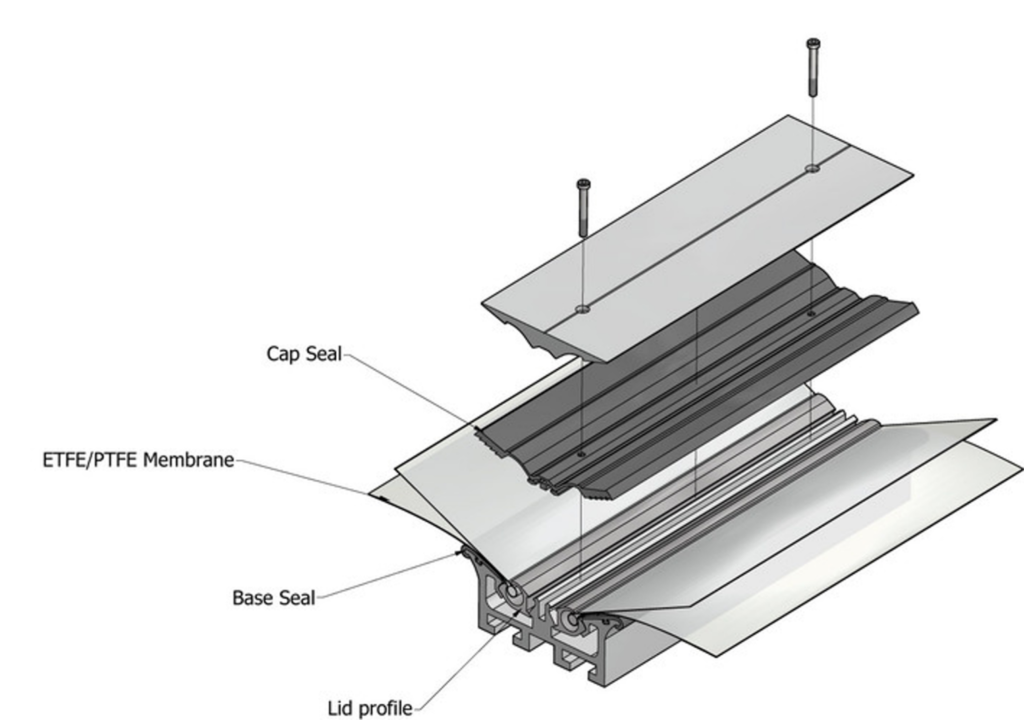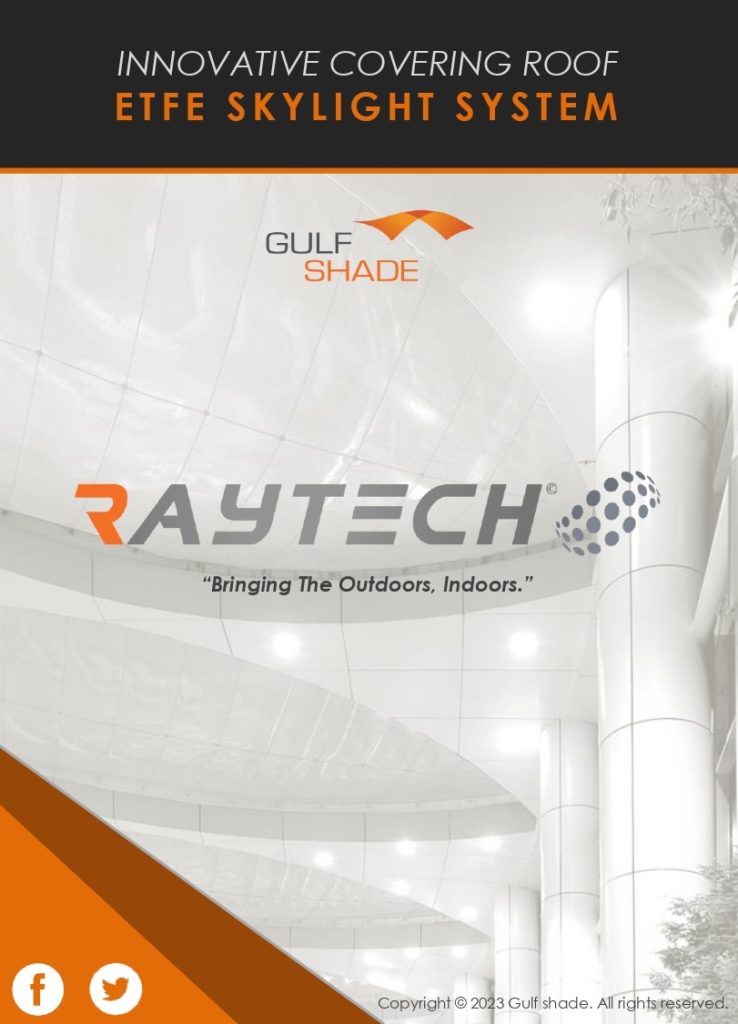INTRODUCTION
RAYTECH delivers a skylight system that achieves a light-weight structure by the intelligent use of foil materials and extrusion technology, being a superb alternative to the traditional skylight made up of glass.
The foil used, ETFE or Ethylene Tetra Fluoroethylene, is a fluorine-based plastic. ETFE is known to have high resistance against corrosion and at the same time maintain good strength over a wide range of temperatures. Low weight of ETFE, approximately 1% of glass weight, makes it the best alternative for glass structures and is the preferred choice where high light and UV transmission is required.
The ETFE foils can have different print designs on the surface as per requirement. These prints also help in controlling optical properties of the system such as light transmission and the thickness and area coverage of the print can be controlled in order to control the optical properties of the system. Thermal properties such as the U-Value of the system is controlled, to meet the desired requirement, by the number of layers and the thickness of the air gaps within the cushion.
The RAYTECH systems are supported to the building frame using specially designed aluminum extruded profiles. These aluminum profiles are designed to secure the cushion against wind, rain and snow loads.

KEY ADVANTAGES
• Thermal Insulation
• Lightweight
• Durable
• Low Maintenance Required
• Self-Cleaning
• Fire Resistant
• Recyclable
• Printable
• Does Not Deteriorate
• Long Lifespan
SYSTEMS
The use of RAYTECH structures in the architecture sector is on the rise and can be used in two ways; single layer membrane system supported by a cable net or a pneumatic cushion system made up of multiple layers, between two to four layers. These cushions are pressurized by an air handling unit which maintains the pressure within the cushions through a series of sensors.


Foil – Single Layered Cross Section


Foil – Cushion Cross Section
THERMAL INSULATION
The U-Value of the single layer system and a multilayer system is calculated as per DIN 673. The thermal insulation of the multilayer system can be adjusted by changing the number of layers and the air gap thickness which can be as thick as half a meter or more depending on the requirement.
Below are the U-Value of standard single and multilayer ETFE systems:
I. Single Layer, ETFE Foil: 5.8W / m²K

II. Two-Layers System, ETFE Cushion : 1.6W / m²K

III. Triple-Layers System, ETFE Cushion : 1.1W / m²K

LIGHT TRANSMISSION
High translucency of the ETFE foils is another added benefit to the low weight of these foils. With 95% to 97% light transmission rate in the visible light region (380 to 780 nm) and 83% to 88% in the ultra violet range (300 to 380 nm), RAYTECH systems provide a sufficient environment where plants and vegetation can thrive.
The solar gain can be control by printing or fritting, with wide range of patterns, on the ETFE film where high level of light transmission is not required. In addition, the thickness and coverage area of the print can be adjusted to further control the optical properties of the system.


Section of Standard Patterns
G-VALUE (SOLAR HEAT GAIN)
G-Value, also known as total solar energy transmittance, is a coefficient used to measure the transmittance of solar gain through glazing or ETFE system. Solar gain is the increase in the thermal energy of the space, object or structure as it absorbs heat energy from solar radiation.
Visible light can easily and almost uninterruptedly pass through glass or ETFE system. However, when glass or ETFE foils are hit with direct sunlight, they will absorb the short-wave infrared waves causing them to increase in temperature and then re-radiate this heat energy in the form of longer infrared wavelengths. These longer infrared wavelengths are no longer able to escape back through the glass or ETFE foils due to their larger size. Therefore, the heat is trapped inside the room causing solar gain.
A G-Value of near 1.0 shows that the window or ETFE system transmits all or close to all of the solar radiation that hits the surface while a g-value of near 0.0 represents that a window transmits almost none or none of the solar radiation that hits the surface.
There are multiple ways of treating the ETFE foils in order to control the solar gain factor of the system. These ways include adding print or frit pattern on the top layer of the system, adjusting the print thickness and coverage area, using specially designed foils for reducing solar gain.
AIR HANDLING UNIT
The multilayer cushions require to be under a constant pressure of 250 – 350 Pa, depending on the design, to attain its design shape and attain structural stability and be able to withstand weather conditions such as wind, rain and snow. The cushions need to be maintained at the design pressure which is done by special air handling unit (AHU). The entire roof system with multiple ETFE cushions can be connected to 1 or multiple of these AHUs.
The AHU supplies clean dehumidified air for ETFE roofs through a series of filter, dehumidifier and air blowers. The control panel is equipped with a programmable controller which controls the air flow and maintains the pressure inside the ETFE cushions through the feedback from the sensors.


The machine includes two variable speed fans which work alternatively at different speeds depending on the pressure inside the cushions. In case of an emergency, both fans work together at full capacity. In case of failure of either of fans or failure to maintain the preset pressure, the external error indicator light turns on and also the screen of the programmable controller changes to red.
POWER LOSS
In the unlikely event of a power loss, the cushions will maintain the shape and minimum required pressure for 2 to 5 hours before deflating, depending on the weather conditions. Once the cushions are deflated, they are under the risk of getting damaged specially during harsh environmental condition. In order to avoid such situation, it is recommended to provide a secondary stand by power.
MAINTENANCE
The smooth surface of the ETFE foils in the RAYTECH system does not allow any major dirt accumulation on the surface and the rain washes away any bird dropping from the surface. As a result, the ETFE roof does not require frequent cleaning and washing the roof every 2 to 3 years should be sufficient. During the washing of the roof, pouring water from a garden hose should be sufficient enough to clean the ETFE foils.
REPAIR & REPLACEMENT
One of the outstanding characteristics of ETFE foil in this RAYTECH system is its exceptional tear resistance, lack of notch weakness and stress crack concentration. Minor damages such as puncture holes or straight cuts can be easily repaired at site by trained professionals. To repair these damages, a special ETFE tape is cut as per requirement and applied on damaged area to block any air leakage.
In case of severe damage to the cushion, where the whole cushion needs to be replaced, the individual damaged cushion can be removed and replaced with a new cushion by trained professionals without disturbing the adjacent cushions.
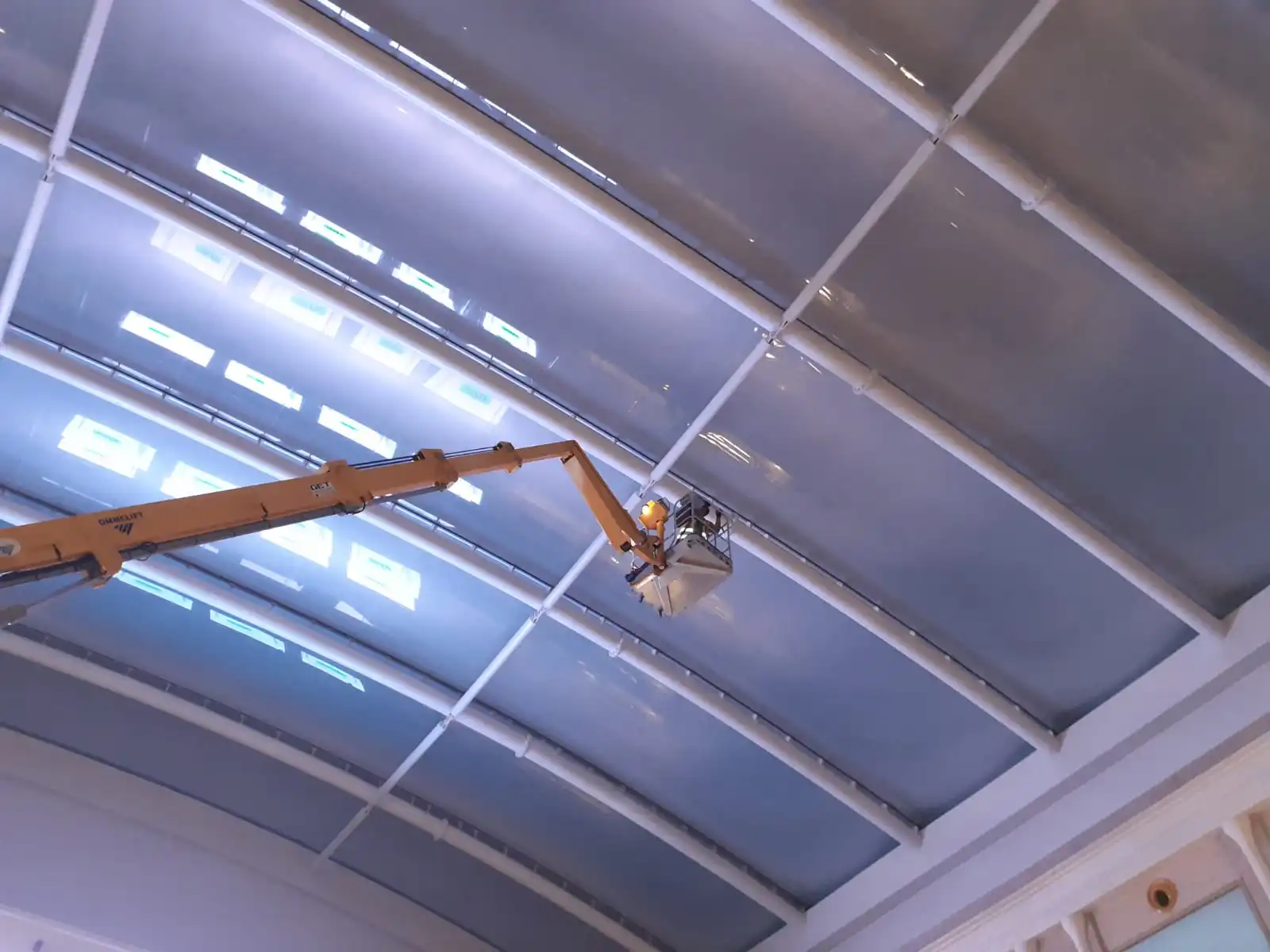
CUSHION DIMENSIONS
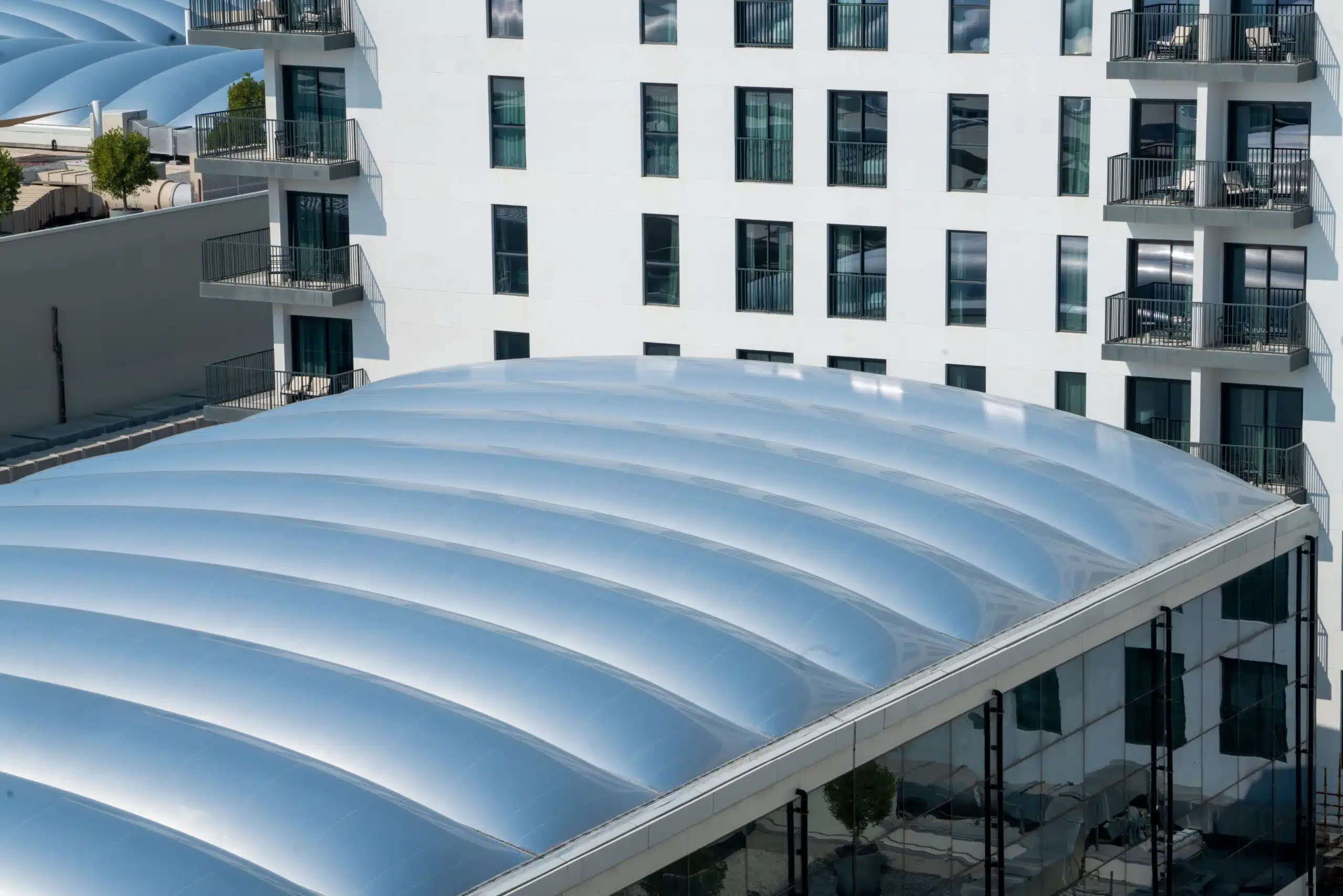
Wind and snow load on the cushion and the orientation of the cushion generally affect the size of the cushion. As a general design guideline, rectangular cushions can span up to 3.5m in one direction and as long as required in the other direction. Larger cushion can also be manufactured noting that they are reinforced by cable net both internally and externally.
LIFE EXPECTANCY
ETFE foil has an excellent life expectancy as it is unaffected by UV light, atmospheric pollution and other forms of environmental weathering.
While no ETFE structures have been in place for long enough to gain a true understanding of the full life cycle of the foil, the material has been extensively researched and tested in a laboratory environment and out in the field.
These tests have concluded that no degradation or loss of strength has occurred and there is no sign that the material will become brittle or discolor over time. As a result, it is anticipated that the material has a life expectancy in excess of 50 years.
FIRE PERFORMANCE
With a melting point of approximately 270 ᵒC, the ETFE foil is considered to be self-extinguishing. In the event of a fire, ETFE film neither promotes spread of fire nor any formation of flaming particles or droplets. If hot gases or flames come into contact with ETFE cladding forming part of the building envelope it will melt and shrink back from the area affected allowing hot gases and smoke to be vented from the building.
ETFE foil has been comprehensively tested. This is a selection of the fire results:
| DIN 4102 | Class B1 |
| EN 13501-1 | Class B-s1,d0 |
| NFP 92-505 | M2 |
| NFPA 701 | Pass |
For more information on specific fire tests, please contact Gulf Shade.
ACOUSTIC PERFORMANCE
ETFE foil roofing, whether single layer or cushion, is acoustically transparent and thus has no effect on the acoustics of the space.
Rain noise reverberated and reflected over multiple tensioned surfaces can make a space uncomfortably noisy when using ETFE cushions. In this case, we provide a rain suppressor layer tensioned over the top surface of the cushions that acts as a dampener, preventing sound from reverberating around the space below and lowering noise levels by up to 10dB in heavy rain (Annex A of BS EN ISO 140-18:2006).
In most cases, installing a rain attenuation layer is only necessary in extreme cases. Because this can be retrofitted to the ETFE foil cushion system, we recommend that rain noise be assessed before making a decision to install.
BIRDS & BIRD WIRE
Wind and snow load on the cushion and the orientation of the cushion generally affect the size of the cushion. As a general design guideline, rectangular cushions can span up to 3.5m in one direction and as long as required in the other direction. Larger cushion can also be manufactured noting that they are reinforced by cable net both internally and externally.

RAINWATER & DRAINAGE
To avoid any ponding of water on the ETFE surface, the structure is given a curvature. This curvature allows the rain water to naturally flow to the perimeter where it can be collected in the main drain gutter. The water is further discharged to the outlet from the drain gutter.
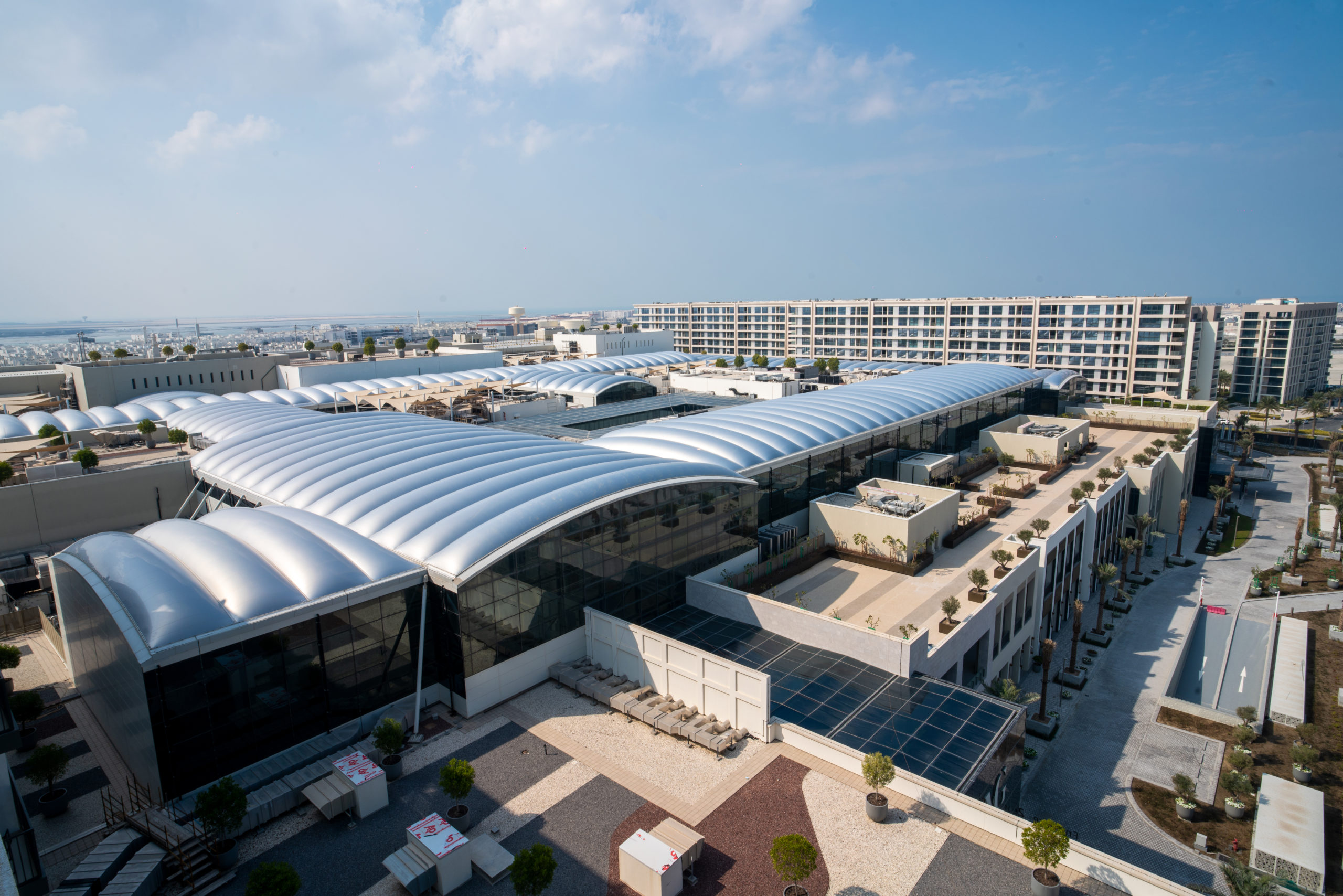
PRODUCTION
Gulf Shade has an in-house production facility of 1600 m2 with 3 independent ETFE production lines. With the available facility we can fabricate up to 120,000 m2 of ETFE every year.
ETFE foils of different thickness comes from selected suppliers ensuring the quality standards set by the company are met. Once the design pattern has been received by the production department from the engineering department, the panels are cut as per the design measurements by high tech CNC plotter cutter, ensuring minimum to zero deviation from the design.


The cut panels are then forwarded to the welding area where the panels are welded together by special welding machines to form the final shape. Once the welding is completed and all the panels and layers are jointed together, the completed cushion goes under quality inspection where the cushion is inspected for any defects such as damaged joints, puncture, abnormal marks, etc.
After the completion of the quality inspection and receiving clearance from the QA/QC department, the cushion is cleaned and packed into wooden box and is ready to be delivered to site.
ENVIRONMENTAL CREDENTIALS
ETFE can be easily recycled, however, due to its remarkable properties such as UV resistance, weather resistance and pollution resistance, the ETFE foils have a very long life which is estimated between 50 -100 years, making the need for recycling small. ETEF suppliers can easily recycle the excess material that is left behind during the production of the cushions. While on the other hand, the aluminum extrusion frames also have a long life and can be recycled when they reach the end of their life.
TYPICAL CONNECTION DETAILS

Details Between Two Cushions

Details At The End of Cushion
ALUMINUM PROFILE DETAILS
